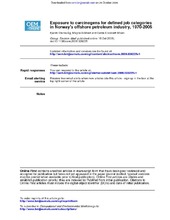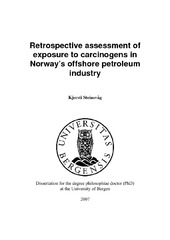| dc.description.abstract | Objectives: The main research objective of the four articles comprising this dissertation was to provide retrospective exposure information for a planned study on cancer in a cohort within Norway’s offshore petroleum industry. Methods: Background information on possible exposure was obtained through company visits, including interviewing key personnel (n = 83) and collecting monitoring reports (n = 118) and other relevant documents (n = 329). The collected material was used to identify relevant carcinogens. Twenty-seven job categories were defined based on a previous questionnaire administered to present and former offshore employees in 1998. Descriptions of products containing known and suspected carcinogens, exposure sources and processes were extracted from the collected documentation and the interviews of key personnel (Article II). Exposure data on oil mist and oil vapour covered 37 drilling facilities and were analysed by descriptive statistics and by constructing linear mixed-effects models (Article I). A group of three university and five industry experts individually assessed the likelihood (unlikely, possible or probable) of exposure for combinations of 17 carcinogens, 27 job categories and four time periods (1970–1979, 1980–1989, 1990–1999 and 2000–2005). Each rater was to assess 1836 combinations based on summary documents on carcinogenic agents, which included descriptions of sources of exposure and products, descriptions of work processes carried out within the different job categories and monitoring data. Interrater agreement was calculated using Cohen’s kappa index and single and average score intraclass correlation coefficients. Differences in interrater agreement between the different time periods, raters, carcinogen class and amount of information provided were then studied (Article III). In subsequent plenary discussions, the experts agreed on exposed combinations. Agreement between the individual and the panel assessments was calculated using Cohen’s kappa index. Using the panel assessment as reference, sensitivity and specificity were estimated (Article IV). Results: This study indicated possible exposure to the following known and suspected carcinogenic agents, mixtures or exposure circumstances: benzene; mineral oil – inhalation exposure; mineral oil – skin exposure; crystalline silica; asbestos; refractory ceramic fibres; formaldehyde; tetrachloroethylene; trichloroethylene; welding; nickel compounds; chromium [VI]; lead; crude oil – skin exposure; diesel engine exhaust; dichloromethane; ionising radiation; and occupational exposure as a painter (Article II). Monitoring reports were obtained on seven agents: benzene, mineral oil mist and vapour, respirable and total dust, asbestos fibres, refractory ceramic fibres, formaldehyde and tetrachloroethylene (Article II). The arithmetic mean of 367 personal samples of benzene was 0.037 ppm (range: less than the limit of detection – 2.6 ppm). Asbestos fibres were detected (0.03 fibres/cm3) when asbestos-containing brake bands were used in drilling draw work in 1988. The personal exposure to formaldehyde in the process area ranged from 0.06 to 0.29 mg/m3. Samples of oil mist and oil vapour had been taken during the use of three generations of hydrocarbon base oils: diesel oils (1979–1984), low-aromatic mineral oils (1985–1997) and nonaromatic mineral oils (1998–2004). Sampling done before 1984 showed high exposure to diesel vapour (arithmetic mean = 1217 mg/m3). Downward time trends were indicated for both oil mist (6% per year) and oil vapour (8% per year) when the year of monitoring was introduced as a fixed effect in a linear mixed-effects model analysis. Rig type, technical control measures and mud temperature significantly determined exposure to oil mist. Rig type, type of base oil, viscosity of the base oil, work area, mud temperature and season significantly determined exposure to oil vapour. In these models major decreases in variability were found for the between-rig components (Article I). In the individual expert assessment overall, 336 (18%) of the 1836 combinations were denoted possible exposure, and 253 (14%) scored probable exposure. Stratified on the 17 carcinogenic agents, the prevalence of probable exposure ranged from 3.8% for refractory ceramic fibres to 30% for crude oil. The overall mean kappa (κ) was 0.42; single score intraclass correlation coefficient was 0.62, and the average intraclass correlation coefficient was 0.93. Providing limited quantitative measurement data was associated with less agreement than for equally well-described carcinogens without sampling data. The eight experts assessed 1157 (63%) of the 1836 combinations in plenary, resulting in 265 (14%) agreed exposed combinations. The agreement between the experts’ individual assessments and the panel assessment was κ = 0.53–0.74. The sensitivity was 0.55–0.86 and specificity 0.91–0.97. For these parameters, there were no apparent differences between the university experts and the industry experts. Conclusions For defined job categories in Norway’s offshore petroleum industry this study describes possible exposure to known and suspected carcinogenic agents, mixtures or exposure circumstances. An expert panel agreed on probable exposure for 265 of 1836 possible combinations of 17 agents, 27 job categories and four time periods. Measurement data on seven agents are presented. Benzene and mineral oil mist and vapour were considered to have the best potential for development of quantitative estimates of exposure. Exposure to oil mist and oil vapour declined over time in the mud-handling areas of offshore drilling facilities. Exposure was associated with rig type, mud temperature, technical control measures, base oil, viscosity of the base oil, work area and season. The eight raters in the expert group seemed to have enough documentation on which to base their individual estimates. However, providing limited monitoring data leads to more incongruence among raters. The group was large enough to give reliable estimates. The experts’ individual ratings highly agreed with the succeeding panel assessment. The university experts and the industry experts’ assessments did not apparently differ. | en_US |




